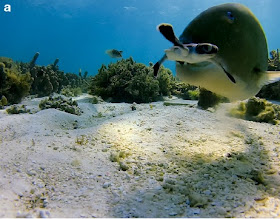Anvils, rocks against which hard foods can be broken, have long been regarded as an example of tool use in Primates, and are considered by some to have been a key stage in the development of stone blades (made by banging rocks to chip away sharp fragments) by early Humans. This behaviour has also been seen in some non-Primate animals, such as Corvids (Crows), and is regarded as evidence of tool use, and therefore intelligence, in these groups too. One remarkable and unexpected group in which this has been seen are Wrasse, Labridae, small and often brightly coloured carnivorous Fish that are found on Coral or rocky reefs around the world.
In a report published in the journal Coral Reefs on 12 April 2016, Alastair Harborne and Brittany Tholan of the School of Biological Sciences at The University of Queensland describe the first known instance of tool use in the Blue Tuskfish, Choerodon cyanodus.
The Blue Tuskfish is large (up to 70 cm), Coral-reef dwelling Wrasse found around much of the coast of Australia and other areas of the Indian Ocean and western Pacific. It is occasionally sold as an aquarium Fish.
Harborne and Tholan observed an adult Blue Tuskfish incidentally from a fixed video camera deployed on part of the outer Barrier Reef near Heron Island, Queensland. The Fish were using a small rock as an anvil, repeatedly striking a small Green Sea Turtle, Chelonia mydas, against the rock. A small Coral outcrop was used for the same purpose. It was unclear if the action was intended to break open the Turtle's shell or simply to kill or stun the animal, since the Fish moved out of camera shot before the action was complete.
Choerodon cyanodus entering the frame with a live, juvenile Chelonia mydas. Harborne & Tholan (2016).
This is the first time that anvil-use has been seen in a Blue Tuskfish, though it has previously been observed in the closely related Blackspot Tuskfish, Choerodon schoenleinii. It is also the first time that one of these Fish has been observed using an anvil to tackle Vertebrate prey; the technique has only previously been recorded being used against Molluscs and Crustaceans.
Choerodon cyanodus striking the Turtle against a rock. Harborne & Tholan (2016).
See also...
 New species of Wrasse from the Unfortunate Islands. Wrasses (Labridae) are small, carnivorous Perciform Fish found in marine
waters across the world. They are a diverse group with many...
New species of Wrasse from the Unfortunate Islands. Wrasses (Labridae) are small, carnivorous Perciform Fish found in marine
waters across the world. They are a diverse group with many... Head-Butting in Giant Bumphead Parrotfish. Giant Bumphead Parrotfish (Bolbometopon muricatum) are the largest
species of Parrotfish, and indeed the largest non-carnivorous fish of any
description inhabiting modern coral reefs, reaching 150 cm in length and 75 kg
in weight. They have a major...
Head-Butting in Giant Bumphead Parrotfish. Giant Bumphead Parrotfish (Bolbometopon muricatum) are the largest
species of Parrotfish, and indeed the largest non-carnivorous fish of any
description inhabiting modern coral reefs, reaching 150 cm in length and 75 kg
in weight. They have a major...
 New species of Parrotfish from the East Atlantic. Parrotfish are a form of Wrasse with
highly specialised dentition, in which the teeth are tightly packed
together to form a sort of beak, used to break off chunks of...
New species of Parrotfish from the East Atlantic. Parrotfish are a form of Wrasse with
highly specialised dentition, in which the teeth are tightly packed
together to form a sort of beak, used to break off chunks of...
Follow Sciency Thoughts on Facebook.


